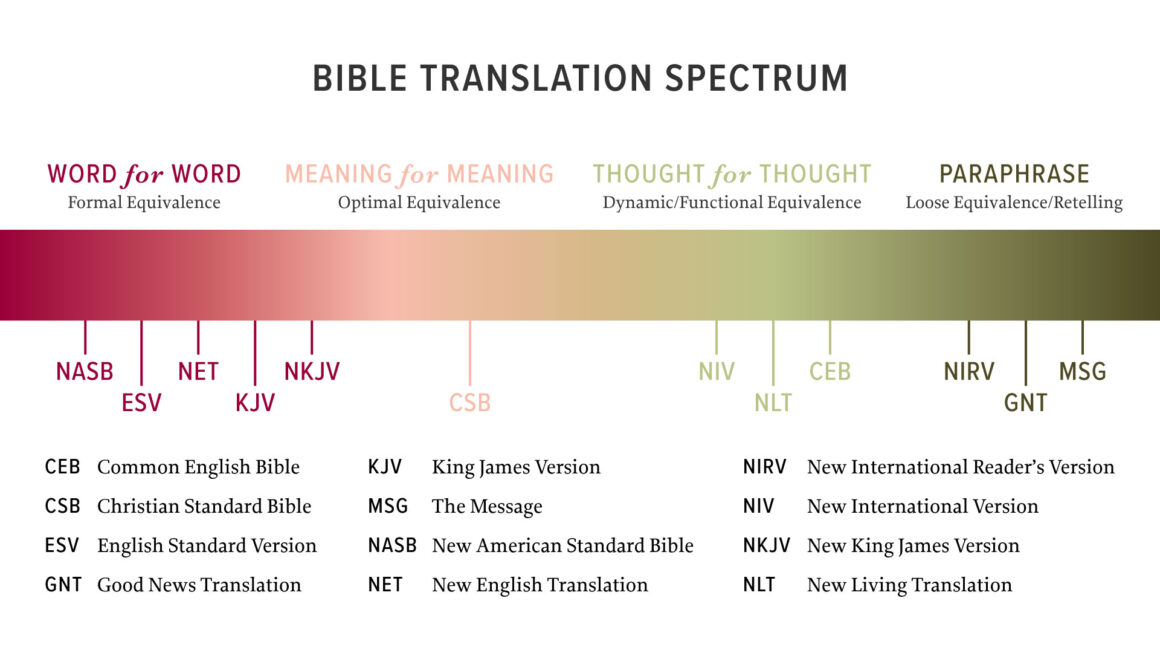One of the questions we often receive here at Hosanna Revival is, “What are the differences between the Bible translations you offer?” Sometimes, what people really want to know is, “Which Bible translation is best?” The truth is, there’s no one right answer to that question. In fact, we think a better question is, “Which Bible translation is best for me?” Before we can answer that question, we need to understand a little bit more about how the Bible is translated. There are two main translation philosophies when it comes to translating the Bible:
- Word-for-Word translation (also known as “essentially literal” or “formal equivalence”)
- Thought-for-Thought translation (also known as “functional equivalence” or “dynamic equivalence”)
In recent years, some Bible translations have attempted to fall somewhere between these two philosophies, forming a “natural equivalence” or “optimal equivalence” translation philosophy. In addition to these three translation philosophies, some have chosen a different method altogether, resulting in a paraphrased retelling of Scripture.

Rather than thinking of Bible translations on a “best to worst” spectrum, it is more helpful to view them on a “literal” to “paraphrase” spectrum. Bible translations shouldn’t be considered as an “either-or” as though they are in competition with one another, but as a “both-and.” Reading multiple translations of the Bible will greatly benefit your understanding as you read and study God’s Word.
The reason it’s not helpful to rate Bibles from “best” to “worst” is simply because the goal of each translation philosophy is different, so it’s not exactly apples to apples. That’s not to say that there aren’t bad Bible translations. Some cults and religions have chosen to impose their systems of belief on the Bible and have altered the text in a way that promotes their ideas rather than saying what the Bible truly says.
Word-for-Word Translation
The goal of a “word-for-word” translation like the NASB, ESV, or the KJV is to carefully translate each word from the original language to the closest equivalent in the English language. Because the English language is different than Hebrew and Greek, sometimes this means the grammatical structure and syntax will be a bit clunky or harder to read. So while it may be a very literal translation, it may be more difficult to understand.
Thought-for-Thought Translation
The goal of a “thought-for-thought” translation like the NIV or the NLT is to consider how the original audience would have understood the text, and render the same thought to its current reader. This means that some of the structure may be altered to improve the flow of a sentence; a prepositional phrase that was at the beginning of a sentence may now be at the end of the sentence, and so forth. So while it may be easier to read, it may not always be as accurate to the original text.
Best-for-You Translation
So, which Bible translation is best for you? It depends! For in-depth study and personal development, I would recommend a more literal translation like the ESV. For a new believer, group studies, or someone who’s never read the Bible, a more dynamic translation like the NLT or NIV may be best. If you’d like something in the middle, the CSB is a great option.
Whichever translation you choose, the most important thing is to read it. In his divine providence, God has chosen to reveal himself to us through his Word. The Bible is a truly amazing book—a living book (Hebrews 4:12). Read it. Treasure it. Hide it in your heart.
“Visit many good books, but live in the Bible.”
Charles Spurgeon
Application
Read and compare Colossians 2:9-10 in the English Standard Version (ESV), King James Version (KJV), New Living Translation (NLT), and New International Version (NIV). Journal and take notes as you read. How are they similar? How are they different? If you don’t know Greek (like most people) or have access to commentaries, comparing Bible translations can be very helpful in Bible study.
Further Reading
The Bible in Translation, an essay by Mark L. Strauss (PhD, University of Aberdeen)
Image credit: Emilee Carpenter
William Burrows is the marketing lead at Banner of Truth. He is passionate about biblical literacy, biblical theology, and loves teaching and preaching the Word. He lives in Pennsylvania with his wife and his five beautiful, handsome, striking sons. William occasionally blogs at williamburrows2.com and you can follow him on Instagram and Twitter.







2 comments